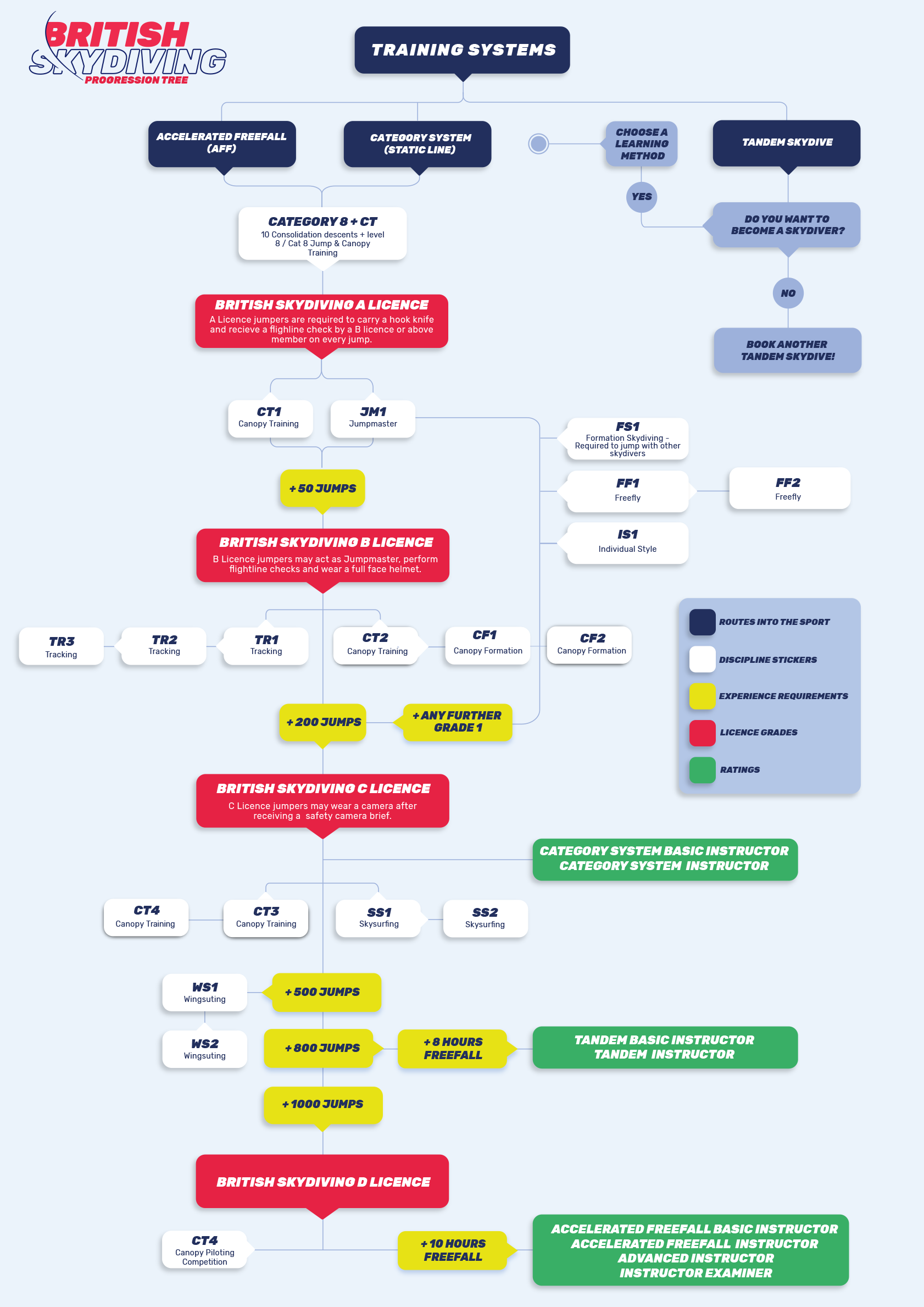What Next?
To keep yourself motivated always go skydiving with a goal in mind, until now that goal was aimed at getting qualified. The following information highlights some of the short-term goals you could now be aiming for, the most common after CT1 and JM1 is FS1. These are taken from the British Skydiving Operations Manual, Section 2, Paragraph 6, The Grading System.
-
You will have already completed a Canopy Training written examination in order to achieve your A Licence. CT1 builds upon these skills covering more canopy techniques. This is one qualification required to achieve your B Licence.
-
A set of skills and knowledge which are required in order to take charge of an aircraft load of skydivers. You also need to be able to undertake packing, inspection and basic fault finding on ram air canopies and equipment. This is one qualification required to achieve your B Licence.
-
Teaches you how to fly relative to other people in freefall, eg moving up/down, forwards/backwards, taking grips etc. It’s also the minimum set of belly to earth (eg flat) skills which are required to skydive safely with other people. For more, see the FS Student Manual
-
FS1 teaches the basic survival skills for jumping with other people in a belly to earth position, Freefly 1 builds upon that to teach the minimum set of skills for jumping with other people in a head up position, eg sit flying. Before progressing to other body positions, eg FF1, you need to demonstrate sufficient belly to earth skills first, see Operations Manual section 2, 6.6.2.
-
Teaches the skills necessary to fly your canopy relative to others and leads into building simple canopy formations, such as stacks.
-
A ‘Classic’ discipline, individual style, is all about learning fast but precise solo body position control.
-
The tracking position enables you to reduce your vertical speed and increase horizontal speed.
To begin TR1 you first need a B Licence, you can then be introduced to tracking in a belly to earth position.
-
Wingsuits, when flown correctly, greatly reduce your vertical speed in exchange for horizontal speed. To get started, you need 500 jumps or at least 200 jumps within the last 18 months. Once you can demonstrate you’ve mastered basic belly to earth techniques – those covered in FS1 – you can be introduced to wingsuiting by a coach.
The WS1 qualification covers the skills needed to safely exit, fly and deploy in a wingsuit, as well as understanding the extra flight planning that is needed due to the horizontal distance that will be covered. After WS1 you can learn the skills needed to jump with other wingsuiters, including diving down to a target, increasing and decreasing forward speed, sideways movement and recovery from instability
-
It may now seem that instructors are prioritising people who are unqualified and experienced skydivers just want to do their own thing. The important thing to remember is that there are lots of solutions to this. To get started, find out from your CI or Instructors if there are any local coaches or experienced skydivers who are allowed to jump with you. See the calendar of events and Skydive the Mag for events including British Skydiving skills coaching roadshows at which coaches are available. Keep an eye on the British Skydiving Facebook page too.
-
It is also great to have some more long term goals in mind. These are the skills which skydivers spend years practising and perfecting. Some longer term goals may include becoming a coach or instructor, high performance canopy flight, free fall videographer, wing suiting, taking part in competitions, building very large formations, jumping all over the world, etc.
-
When it comes to sources of additional information there are some great, some completely incorrect and then everything in between. The best sources of information are your local instructors and Chief Instructor (CI). The reference document which lays out the rules of skydiving in the UK is the British Skydiving Operations Manual. This British Skydiving website and Skydive the Mag are other great sources of written information. Information sources to be cautious of – fact check with your instructors – might include the Drop Zone bar and internet.
-
British Skydiving is recognised by the Civil Aviation Authority (CAA) as the governing body for the control of all sport parachuting/skydiving in the UK. The rules and regulations (British Skydiving Operations Manual) are laid out in a fashion to ensure that British Skydiving does everything in its power to maintain the highest levels of safety possible. As a consequence instructors may err on the side of caution, especially if you are unfamiliar to them, when asking them for permission to partake in certain disciplines or use new pieces of equipment.
-
If you have not already you will soon realise that skydiving does involve significant costs. The biggest of these costs in the immediate future may be related to buying your own equipment. You will probably want to pick up the basics fairly quickly, eg helmet, goggles, altimeter, gloves, hook knife, jumpsuit, but your own rig may require a bit more forethought. Although there may be a lot of people willing to help, especially those trying to sell you something, you are best of seeking the advice of your instructors or rigger in the first instance.
-
Now that you have your A Licence you can easily jump at any of the Drop Zones throughout the UK or possibly even further afield. If you choose to try a different drop zone there are a few things to be aware of. Make sure all of your necessary paperwork is in order, this includes your new British Skydiving Licence, membership card, an up-to-date, complete log book and if you have your own rig any relevant documents. When you arrive at a new drop zone expect to receive a full kit & document inspection as well as a drop zone brief, which explains all local operating procedures. To ensure your skydives are as constructive as possible, most drop zones, if you contact them in advance, might be able to arrange a coach especially for you!
-
The following is intended for guidance only and we advise you to consult the full terms and conditions using the primary source of the Royal Aero Club Trust’s own website:
Royal Aero Club Trust Bursaries are offered annually. The closing date for applications is normally 31 March.
- Are you a British Skydiving Member aged between 16 years and 21 – or 24 for a ‘follow-on’ bursary, see * below?
- Got a basic skydiving qualification?
- Want to advance your skydiving qualifications but lack the funds?
- Would a bursary of up to £1,000 help you realise your skydiving ambitions?
* Additionally, the Trust has introduced a ‘follow-on’ bursary for young people up to the age of 24 to train to take part in national / international competitions or as instructors, etc.
The bursaries include The President’s Scholarships (2 bursaries each worth up to £750), the Peter Cruddas Foundation Scholarship worth up to £1,000, the Breitling Bursary also worth up to £750, and the Bramson Bursary which is one of a number of additional bursaries worth up to £500 each to anyone between 14 and 21 years of age wishing to progress their interest in either air sports or aviation, which includes skydiving (British Skydiving is a Member of the Royal Aero Club of the United Kingdom – the minimum age to skydive in the UK is 16, which requires parent’s/guardian’s consent for those over 16 but under the age of 18).
Applicants must be UK citizens, resident in the UK, and training and flying can only be conducted at Clubs, Associations or training establishments – such as British Skydiving Affiliated Parachute Training Organisations – in the UK. Applications, which must arrive at the Trust by 31 March are to be submitted through a Sponsoring Organisation, Club or Association (for eligible members, your CI, a British Skydiving Council member, or a member of British Skydiving technical staff (COO/STO) can countersign your application.
Full details, rules and an application form are available on the Royal Aero Club Trust website
http://royalaeroclubtrust/bursaries
The Trust is very grateful to its sponsors who generously provide the funds for bursaries. If you, or your organisation, would like to assist young people in this way by becoming a Trust sponsor, please make contact with the Trust or click on ‘Donations’ on the Trust website.
Click the following link to view the list of: Royal Aero Club Trust Bursary Winners 2020


